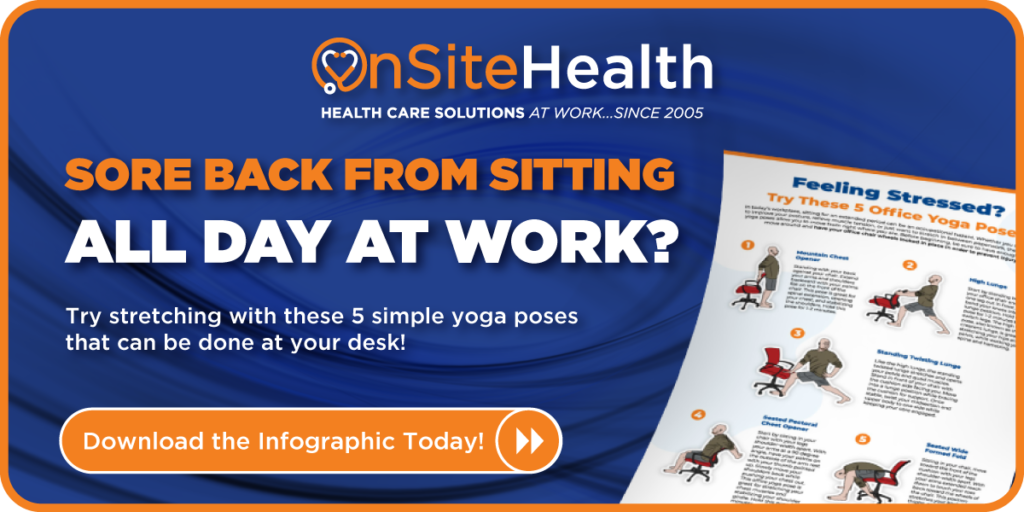Summertime is a busy time for most people; the warm weather and longer days give way to more outdoor activities. Unfortunately, this activity raises the risk of heat-related illnesses, which can critically damage our bodies. Let’s review the treatments for heat-related illnesses.
Staff an OnSite Health Nurse and Save
>>Click Here for our ROI of On-site Nurses Flyer<<
What are Heat-Related Illnesses?
Heat-related illnesses occur from exposure to high temperatures or humidity. Typically, our bodies handle hot temperatures through thermoregulation—which induces sweating to help us cool our internal temperature. If the heat increases too fast, your core temperature can increase and lead to a heat-related illness.
Types of Heat-Related Illnesses and Effective Treatments
Although some types of heat-related illnesses can be handled at home, others require emergency medical care. Here’s a look at the types of heat-related illnesses and treatments:
Heat Stroke
Heat stroke is one of the most serious types of heat-related illnesses that occur if the body is unable to sweat enough to cool down. In turn, the body’s internal temperature can rise to 106°F or higher within 10 to 15 minutes.
Symptoms: Some symptoms of heat stroke include confusion, slurred speech, unconsciousness, dry skin, and seizures. Individuals with heat stroke can develop permanent disabilities, brain damage, or die if untreated.
Treatment: Employers should call 911 if a heat stroke is suspected. While waiting, attempt to cool the employee using a cold wet cloth, soaking them in ice water, and moving them into the shade. Be prepared to provide CPR if necessary.
Heat Exhaustion
Heat exhaustion is a heat-related illness caused by a sudden loss of water and salt in the body, causing dehydration. This exhaustion occurs when an individual sweats excessively from high temperatures.
Symptoms: Heat exhaustion is a result of bodily dehydration. Typically, this causes individuals to experience headaches, nausea, dizziness, thirst, heavy sweating, and physical weakness.
Treatment: Employers should move the affected employee to a cool area, remove any unnecessary clothing, and provide cool water to drink or apply to the skin using compresses. If they seem confused, worsen, or stop sweating, call 911.
Rhabdomyolysis
Rhabdomyolysis is a condition associated with heat-related stress and physical over-exertion. Rhabdomyolysis causes the body’s muscle tissue to breakdown, rupture, and die, leading to heart arrhythmia, seizures, and kidney damage.
Symptoms: Signs of rhabdomyolysis include muscle cramps or pain, dark-colored urine, or physical weakness. However, there are some cases of rhabdomyolysis that don’t portray symptoms.
Treatment: Call 911 if you suspect your employee has Rhabdomyolysis. Additionally, workers should stop activity, hydrate, and cool the skin with running water or cloths. After reaching the hospital, doctors will draw blood to confirm the diagnosis.

Heat Syncope
A heat syncope is a fainting type of heat-related illness that results from suddenly standing or standing too long. Often, a heat syncope occurs due to dehydration and the inability to acclimate to hot weather.
Symptoms: Individuals with a heat syncope may experience fainting, dizziness, and light-headedness.
Treatment: Workers should sit or lie down in a cool area and hydrate with liquids until recovered.
Heat Cramps
Heat cramps are a heat-related illness that happens when workers profusely sweat during physical activity, thus dropping salt and moisture levels. If untreated, this can cause painful muscle cramps and heat exhaustion.
Symptoms: Individuals with heat cramps may experience painful muscle cramps in the stomach, arms, or legs.
Treatment: Workers should eat or drink until nutrients are replenished. If workers have a medical history of heart problems, call 911 immediately.
Heat Rash
A heat rash is a type of heat-related illness that creates a skin abrasion due to excessive sweating, thus irritating the skin.
Symptoms: Heat rash symptoms include clusters of red bumps or blisters across the neck, chest, elbow creases, and other sensitive areas of the body.
Treatment: For a heat rash, move into a cool area and keep the rash dry using a soothing powder; avoid using creams.
Let OnSite Health Support Your Workers
At OnSite Health, our on-site nurses are professionally licensed and trained to care for and help prevent heat-related illnesses in your workers. With our expertise, we can help your employees to stay healthy and safe all summer long. Contact us today to learn more!





